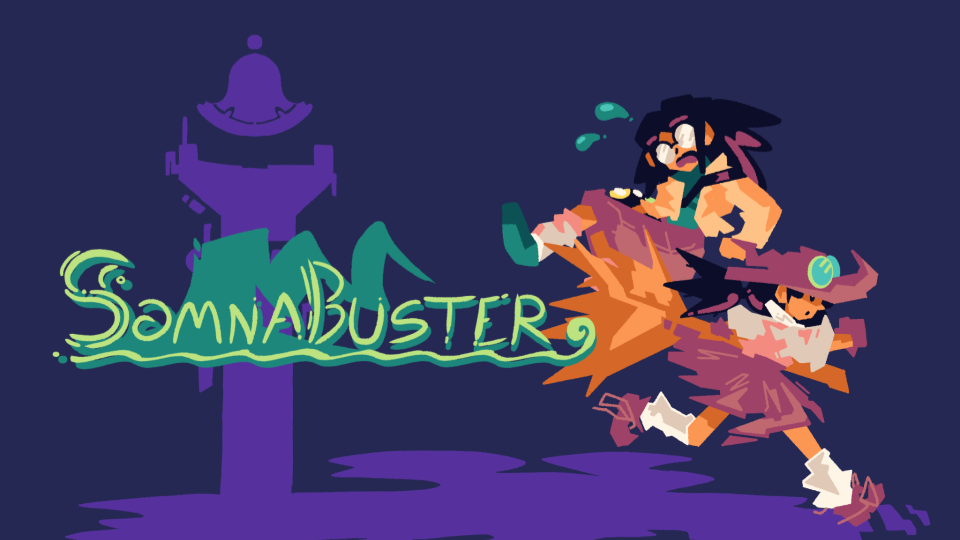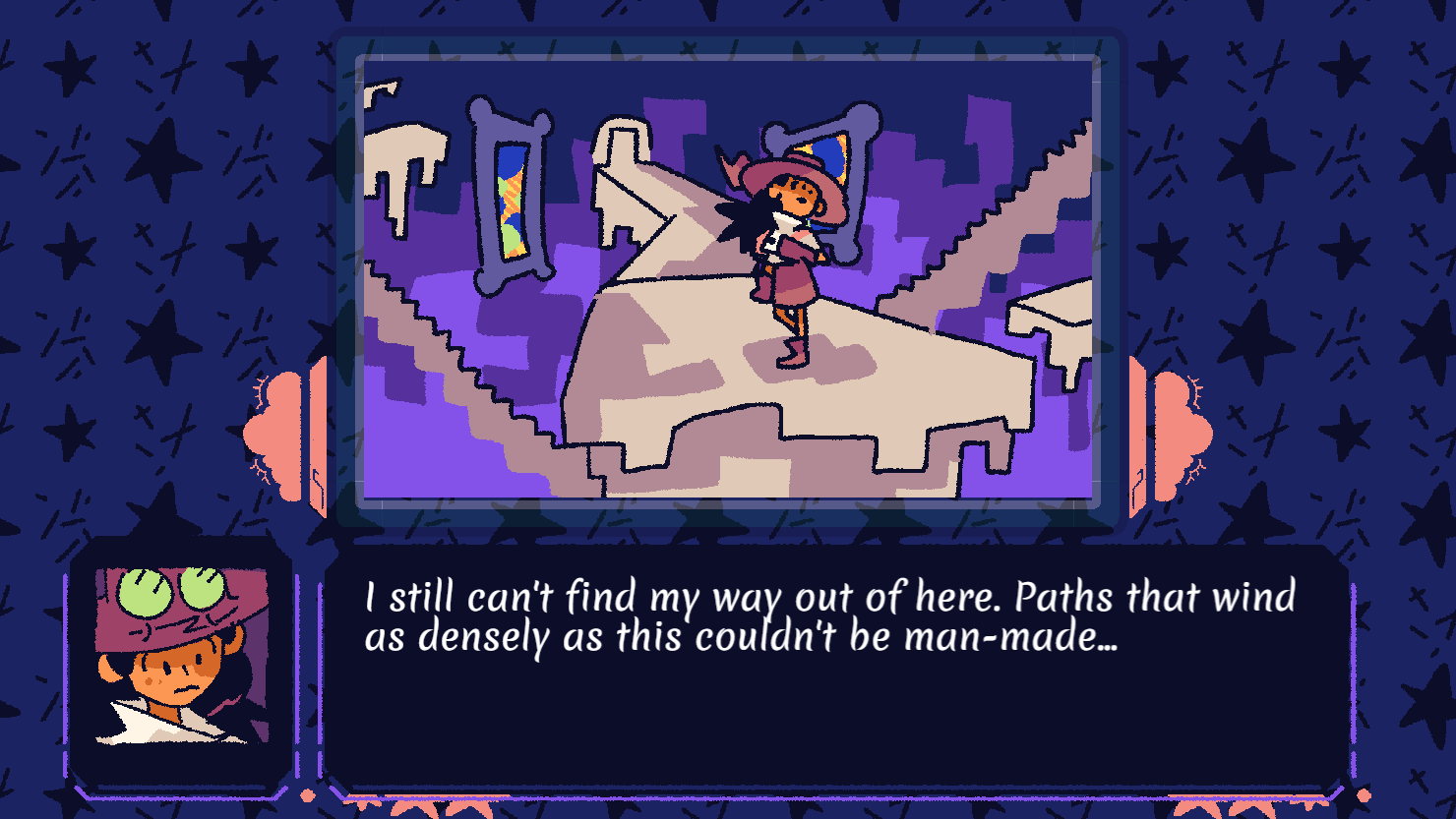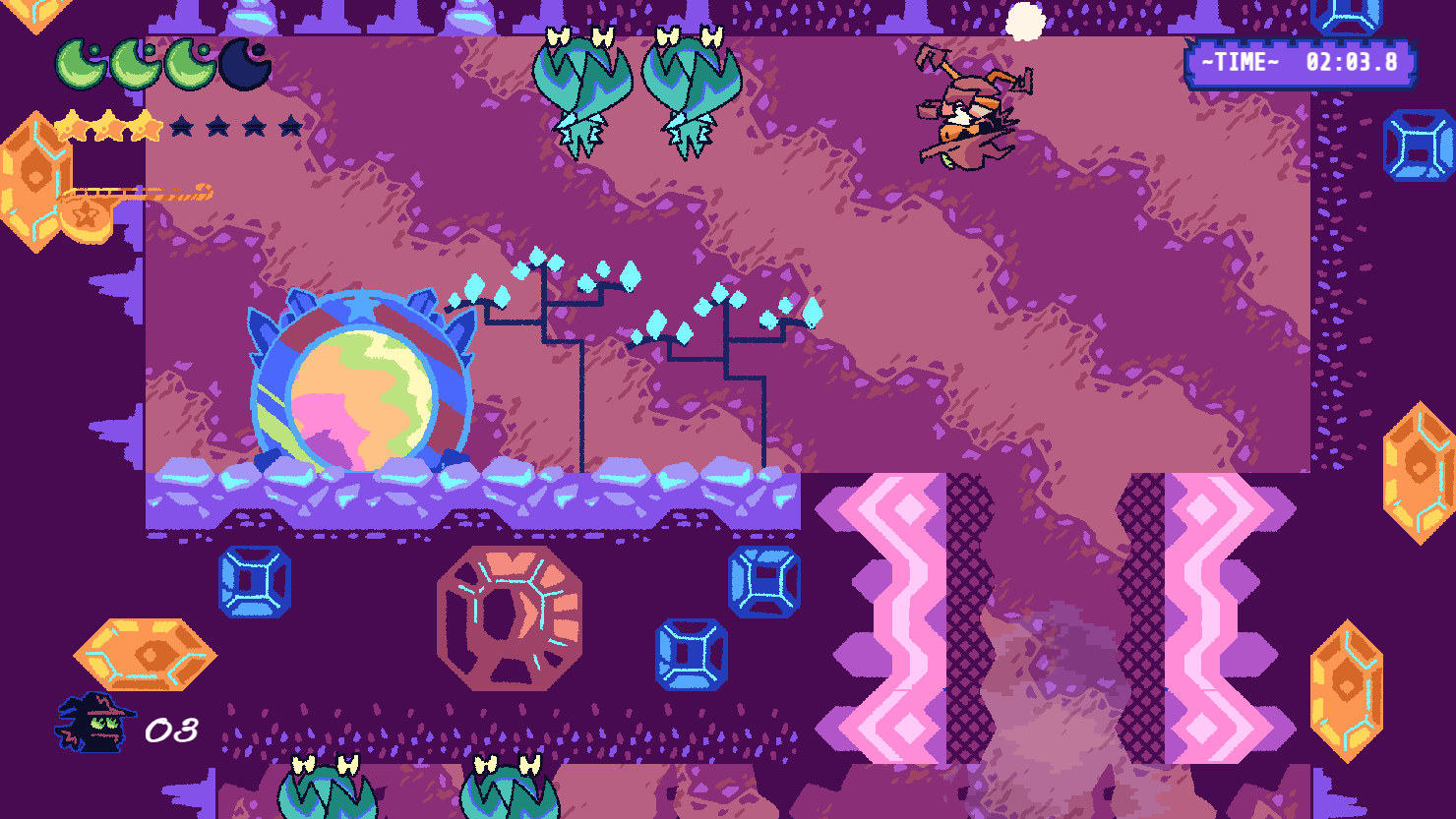Today’s review was written with a copy of the game provided by developer PD_CGT for the sake of promoting this title. Many thanks to PD_CGT for providing us with this opportunity, and know that this review’s opinions are entirely genuine. No money was exchanged in the production of this article. SomnaBuster is an indie platformer game released for Steam and Itch.io on September 24th, 2024. The basic premise is that of a girl waking up in a dreamland as a magical heroine on her quest to return to the waking world. Players engage with the game through text-based cutscenes and 2D platforming challenges, as well as combat against bosses. The time to reach the end credits for me was about 3.5 hours.

The story takes place in the land of Esperanto and follows the story of Dolores the heroine witch. Esperanto is a dreamland on the far side of the world where the tired are transported to for respite from everyday life, and though Dolores can’t seem to remember who she is in reality, she is eager to return there. This prompts her to go on a grand quest to find and ascend Jericho Tower, to beseech the King of Esperanto to return her to earth. That’s about the most I can say in detail without giving away too much, but there is more to say in the abstract. Most of the story is spent largely in observation of the various different peoples of the dreamworld, seeing where they live, what their problems are, and the ways Dolores impacts them. Most platformer games don’t put a lot of effort into contextualizing the locations you visit and characters you find, but SomnaBuster does take the time to present their place in the world and I really appreciate that.
As for the narrative as a whole though, my feelings on it are a bit complicated. Much of the game’s dialogue is written in a very obtuse manner, and while it would be low hanging fruit to suggest that this is textbook artsy indie game nonsense, I would actually defend it in the sense that these more cryptic messages feel right at home in a dreamland setting. I also really enjoyed the way that the story wasn’t content to present obvious answers for every zone in the game, as some of the conclusions to each mini-story were genuinely unexpected and left me with more to chew on than a bog standard game narrative. That being said, there are times where the more obtuse language slides into territory that I can really only describe as sophistry in service of conclusions that are a bit too kitschy in light of everything else in the game. There are also definitely some tonal issues where the game looks and usually acts the part of a more family friendly affair, but often has this weird sense of adult oriented humor which at times made me question who exactly this tale was aimed towards. On the whole I think the term “mixed” probably best describes the narrative in SomnaBuster, as it’s an interesting convergence of insight and foolishness, lightness and seriousness, and naivete and maturity. I’d certainly say I liked the story more than not, mainly because it feels extremely true to its own setting, but small things add up that distract from its strengths.

Moving along to the gameplay, SomnaBuster is a traditional 2D platformer with a focus on unique movement options. Dolores is equipped with a standard runspeed and a basic attack with great disjointed range to make ground traversal a breezy affair. When you leap into the air is where things get interesting—while airborne your attack becomes a spin jump with properties quite similar to a blue hedgehog’s, with all the implications in combat and traversal that comparison entails. In addition to a double jump, Dolores can also perform what is known as a Broom Burst, a technique which halts your midair momentum before rocketing you in the direction of your choice. Lastly there is the fact that the ceilings in the environment are fully traversable so long as you avoid damage. All of these things come together to create a surprisingly fast-paced experience which bends your intuitions on platformer level routing in ways that are challenging but fair, and very satisfying to play. It has to be noted however that the levels you play through feature various contextual elements to shake up traversal in interesting ways, and while these are a positive addition to the game they also tend to lock you out of using Broom Burst if you haven’t used it yet. This leads to a rather odd early game where you might rely heavily on the individual level gimmicks to the point where when the late game comes around you realize you haven’t been using much Broom Burst, and have to learn the more technical uses of it through trial and error. More sections early on to check your knowledge of this central mechanic may have helped to alleviate this.
As for the levels themselves, they’re quite varied from one another in terms of visuals and designs. In addition to the aforementioned contextual elements that change the way you move through the stages, most zones feature unique enemies that demand different approaches to evading or defeating them, and each level is designed with paths for both high-speed sprints and hidden collectible crawls. This may be a pretty short game, but there’s clearly been effort into making the game replayable to different kinds of gamers. I personally want to go back and shave seconds off my time now that I understand how to better use Broom Burst and ceiling walks, but completionists may enjoy the exploratory side of the design more. It is worth mentioning that there are a few instances of beginner’s trap level design though, which doesn’t feel great to die to. There’s also the boss stages, with the ones in World 5 onwards being pretty challenging and interesting while the first four leaving something to be desired with how easy they are to cheese. This is fairly normal when it comes to platformer bosses in games not all about action-combat though, so I didn’t mind them as spectacle fights.

In terms of presentation, SomnaBuster goes for a hand-drawn art style reminiscent of independent web comics and children’s doodles. While far from anything technically impressive, the graphics are well crafted thanks to quickly conveying new information to the player and setting the mood. These drawings really help to sell the dreamworld atmosphere, and in a pleasant twist this game is impressively light on reused assets. Most individual stages have enemies and environmental details that separate themselves from all other sections of the game, so there really is something new to see around every corner. If you like the whimsical, the bizarre, or the unnerving, then there’s a zone in SomnaBuster that will definitely appeal to you. My favorite was definitely the third zone, as I’m a big music lover and enjoyed seeing different instruments used for platforms and grind rails. As for the music itself, even though I probably couldn’t hum any of the tracks to save my life I still thought it was pretty good. The particular soundfont used for the project feels right out of a Sega Genesis title, and that retro touch really ties the whole game together for me.
As for what can be taken from the game from the Catholic perspective, the developers stated that they wanted to draw some attention to their game’s themes of spirituality and the digital age, and I feel obliged to engage with that topic in turn. I will go into a little more detail about the game’s world for the sake of discussion, so if you’re already sold on playing this one consider returning after beating the seventh level. It is in this chapter of the game where Dolores comes to fully comprehend the nature of Esperanto as a place of respite for humans, but also comes to learn that many of the current residents have been using this land as a full-on substitute for reality. This of course is where the crux of the game’s allegory for the internet lies, and while not exactly subtle I enjoyed many of the details the stem from this, like how the forms most of the people in Esperanto take are essentially transformations stemming from staying too long (body-horror was not on my SomnaBuster bingo card, lemme tell ya) in the same way our own digital profiles can sometimes subsume the people behind them. The name Esperanto itself is derived from a real project devised to create a new global language which failed to proliferate, perhaps a reference to the intended initial use of the internet changing and in some cases degrading over time. The conversion between the King of Esperanto and Dolores ultimately teaches us the dangers of letting those failures stop us from doing the right thing, as while our heroine doesn’t defend those who misuse the dreamworld she also doesn’t give the king’s withdrawal a pass in regards to those who genuinely came seeking his aid.
Likewise in reality the internet has burdened our society and the individual hearts of men with problems that only grow more numerous as the technology continues to expand in scope, and it can be very difficult to see the redeeming value of it all sometimes. But it mustn’t be ignored that many great things have been accomplished through the help of the internet, including many sources of charity and evangelization that have become mainstays in the modern mission of the Church. Perhaps there may come a day when the internet is so far gone that we have no option but to withdraw, but so long as a seed of good remains in it we need to do everything we can to see that good triumph and make the internet a place that helps us face reality rather than run from it. Is it not also the case that if any virtue lives in our hearts, God in His Mercy will call us to nurture it to the utmost rather than write us off as unsalvageable because of the stains of sin? The Crucifixion certainly tells us as much. In the end SomnaBuster probably could have benefited in its spiritual value by including some more details about what the King of Esperanto did after his encounter with Dolores, exploring how he learned to balance his (justified) contempt for those who made Esperanto their false god with his rekindled desire to aid the earnest seekers, but this game had a lot to do in not a lot of time so I understand why things are as truncated as they are. It’s a good message overall, and I’m always happy to highlight where game narratives get it right.
In summary, SomnaBuster is a quality game that is conscious of its capabilities and leans into them to create fun gameplay and memorable art direction. It’s a bit on the slim side in terms of campaign length and the narrative sometimes frays while racing against the clock, but if you don’t mind these hiccups then you might find this to be a delightfully digestible platforming experience for your library. If you ever wished The Wizard of Oz had more air dashing in it, SomnaBuster has got you more than covered! Thank you again to PD_CGT for the early review copy, and have a lovely day.
Scoring: 80%
Gameplay: 5/5
Story: 3/5
Art and Graphics: 5/5
Music: 4/5
Replayability: 3/5
Morality/Parental Warnings
SomnaBuster’s protagonist looks the part of and is stated to be a witch, however any serious reference to the occult is basically absent, leaving Dolores as essentially an adolescent take on the Merlin or Glenda archetype. The game’s story occasionally features more adult scenes, with probably the most concerning being the one where a security guard breaks out in licentious moaning at Dolores as a part of a punchline. In a late game cutscene the character Arla says “If I wanted some numbskull helicoptering me all day, I’d go to church!” but she isn’t a voice of reason or a role model, so it’s debatable whether this is to be taken as a serious statement about God. The combat is largely cartoony slapstick against goofy dreamworld foes, nothing too off-putting.
